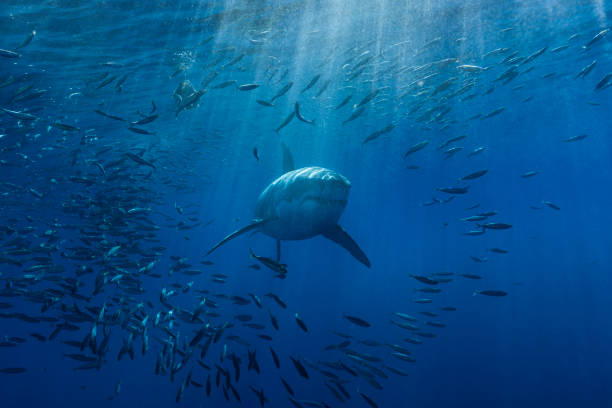
Do sharks live in the Mediterranean Sea? It’s a question that divers and vacationers have been asking for some time. Indeed, when you take a diving excursion in the Mediterranean, you are sure to hear some of your fellow divers talk about seeing “a shark” or “sharks” while underwater.
Unfortunately though, what many people have been reporting as sharks are not really sharks at all. Much of the time, divers have actually seen large barracuda.
Today, we’ll go deep into the fascinating shark world of the Mediterranean Sea.
Are There Sharks in the Mediterranean Sea?
Yes, there are 47 different types of sharks in the Mediterranean Sea, and about 30 of them are generally seen.
The sharks found in the Mediterranean Sea are not very big, except for one type of shark that can get up to 6 meters long (20 ft.) called the Basking Shark, which is the second biggest fish in the world after the whale shark.
Fossils found on some Mediterranean beaches tell us. The temperate and fish-teeming waters of the Med make it the perfect hunting ground for a variety of sharks. What’s more, there’s a real abundance of different habitats spread across the 2.5-million-square-kilometer body of water, from sandy bays to rock reefs to coral gardens and more
The shark species In the Mediterranean Sea
1. Blue Shark:
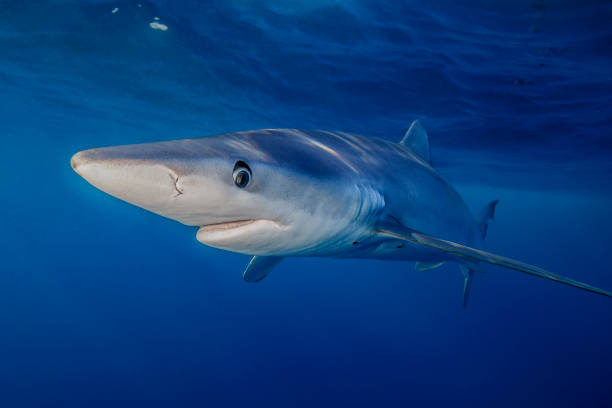
The blue shark is the most abundant of all sharks in the Mediterranean, this animal lives primarily in deep waters, usually far away from shore.
2. Shortfin Mako Shark:
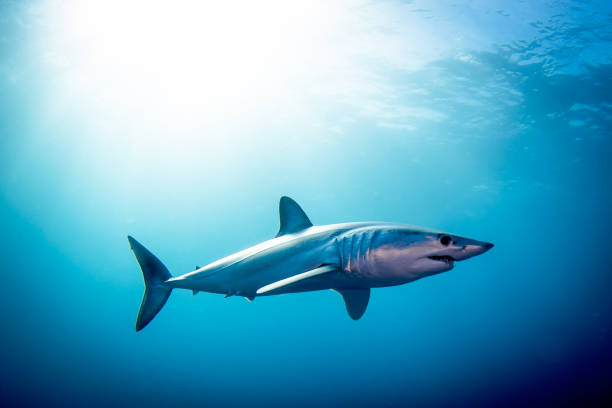
The mako can be found throughout the entire Mediterranean basin, where its presence has been recorded off every coastline. During winter and spring, it migrates to deeper water (about 200 meters), but during summer and autumn, when it is slightly warmer, the mako is very common in shallow water.
3. Thresher Shark:
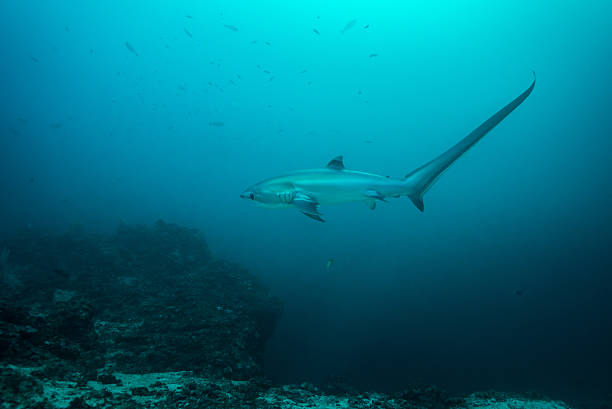
The thresher shark has a long tail fin which it uses like a whip to stun its prey (such as squid and mackerel) before eating them. The thresher can be found throughout the Mediterranean in deeper waters under 100 meters.
4. Hammerhead Shark:
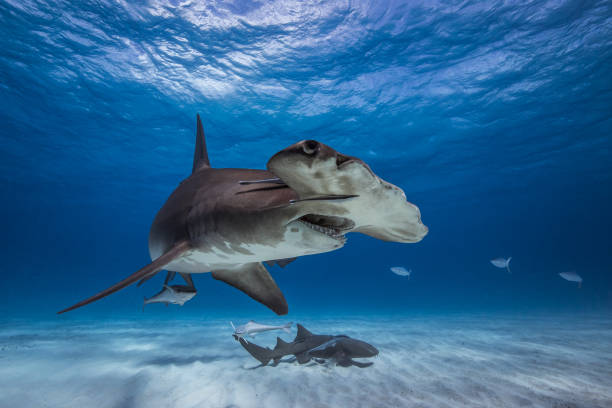
The most distinguishing feature of this fearsome predator is its head with an odd number of lobes or corners that give the hammer-shaped head the appearance of a blunt arrow tip from above. It lives primarily in deep water where it hunts smaller fish and cephalopods and is occasionally seen in very shallow water and relatively close to the shore.
5. Porbeagle Shark:
This shark has a long, narrow body and a conical-shaped snout. It lives throughout the Mediterranean Sea but is most common outside of the summer months because it often enters slightly warmer waters during winter as well as spring.
6. Nurse Shark:

The nurse shark is usually found on rocks, around shipwrecks and caves, but has been known to swim up rivers and into freshwater estuaries (where saltwater meets freshwater) probably looking for fish or crustaceans that live in freshwater (or maybe just escaping from danger). The young nurse sharks can sometimes be seen inside rock pools at low tide or on shallow reefs
7. Bluefin:
This is the largest of all and one of the fastest-swimming fish in the world; it can swim as fast as 50 miles per hour (80 kilometers per hour). This massive creature is very common throughout the Mediterranean Sea but tends to live deeper than most sharks. It’s a popular food around the world
8. Spinner shark:
This shark lives in very close proximity to shore, often swimming along sandy beaches. The spinner tends to live around reefs and also enjoys shallow water with seagrass beds or sea-grass meadows, where it can rest during the day before hunting for fish such as eels, octopus, and squid at night (and eating whatever debris washes off the beach).
9. Blackmouth Shark:

A shy animal that’s been spotted at a depth of up to 200 meters, the blackmouth is named for its distinctive black mouth – which it displays as a warning to predators when provoked.
10. Atlantic Sharpnose Shark:
This small-ish predator has an unmistakably pointed snout – perfect for scouring the seafloor in search of prey like crustaceans and small fish. At about 1 meter long (3 ft.), this shark is one of the smallest in the Mediterranean, although they can grow as big as 2 meters (6 feet) over their 10-year lifespan.
11. Striped Smoothhound:
This shark is named for its smooth back and striped sides, which help it blend into the rocky bottom of the Mediterranean where it hunts fish, crabs, and octopuses. It’s a very common fish in the Mediterranean – so common that some people rely on catching them as a source of income
12. Common Shark:
This shark gets its name from its extremely long tail, which it uses to stun prey before feasting on them. It can grow up to 5 meters (16 ft.) in length but is more commonly spotted at around 2 meters (6 ft.).
13. Bigeye Thresher Shark:

The bigeye thresher shark is slightly smaller than its cousin, the common thresher, but it’s easily identified by its large eyes and long tail.
14. Leopard Shark:
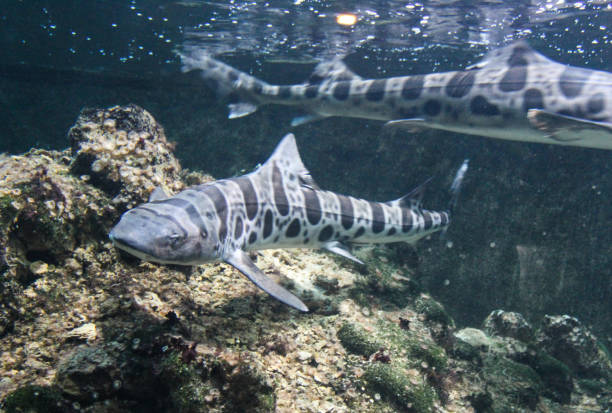
The leopard shark is a shallow-water shark with beautiful spotted skin. Its scientific name means “spotted like a cat,” which refers to this distinctive patterning in adults and juveniles alike. Although it typically lives in waters between 0–100 meters (0–330 ft.), it has been known to swim into freshwater estuaries in search of food or when looking for a place to rest.
15. Atlantic Angel Shark:
This shark may look menacing because of its tall dorsal fins, but contrary to popular belief it’s actually an extremely shy creature and is rarely seen by divers. It gets its name from the fact that it has a flat, angelic face and lives in deeper waters than most sharks.
16. Catshark:
This shark rests on the seafloor during the day and hunts at night, feeding mostly on fish. It’s typically found in waters about 500 meters (1650 ft.) deep, but it has been known to come up to shallower water if food is scarce.
17. Narrow Sawshark:
This shark often hides among rocks or plants so it can ambush prey like a bony fish community. The bigger saw sharks are powerful predators that hunt for larger prey including other sharks and rays, while smaller ones feed primarily on shrimp and crabs. Although they aren’t typically aggressive towards humans unless provoked, they certainly look intimidating!
18. Nursehound:
The nursehound is one of the most common sharks in the Mediterranean and can be spotted off the coasts of France, Portugal, and Italy. Its name comes from the shallow burrows – or nurseries – that it builds along coastal rocks to pup in during the spring and summer months.
19. Smallspotted Catshark:
This shark is most commonly found at depths of 50–200 meters (160–660 ft.) but has been known to come up into the shallows on occasion for feeding opportunities. It hunts small bony fish including mackerel, scorpionfish, gobies, mullets, porgies, sea bream, anchovies, horse mackerels, eels, squid, octopus, crustaceans, shrimp
20. Spiny Dogfish:

This shark has spines in front of both its dorsal fins, which are used for defense against predators. It’s most commonly found in shallow waters close to the shore where it feeds on shrimp, mollusks, crabs, lobsters, small fish, and octopuses.
21. Tope Shark:
The tope shark is a speedy predator that shoots through the water with grace and agility. It’s most commonly seen at depths of 200–500 meters (660–1650 ft.), but can occasionally be spotted swimming in shallower coastal areas looking for food.
22. Mediterranean Nettle Shark:
With an elongated snout and venomous spines on its dorsal fin, you know that this shark isn’t someone to be messed with. The nettle is mostly seen in deep waters of the Atlantic Ocean, but it has been known to migrate long distances across the Mediterranean Sea looking for food. Although this shark is considered harmless to humans, its venom can cause serious symptoms like localized pain and swelling, nausea, dizziness, headache, tiredness, tingling of the tongue
23. Portuguese Dogfish:
Also referred to as a Portuguese dogfish or an autumn shark, this creature stays close to coastal areas during daylight hours where it hunts small fish including gobies, eels, mullets, scorpionfish
24. Roughtail Catshark:
This small shark is often found in waters no more than 100 meters (330 ft.) deep near the coast. It can also be found swimming around seamounts and other rocky structures where it hunts for shrimp, crabs, lobsters, mollusks, octopuses, and fish
25. Whaler Shark:
One of the largest members of the requiem family along with the white pointer, this shark lives primarily in cool temperate waters where it hunts at night. It feeds on bony fish like tuna, mackerel, bonito sardines, sauries, anchovies
26. Bull Sharks:
Bull sharks tend to migrate during warmer months into freshwater rivers looking for places to pup or give birth. They’re not picky about their habitat either and have been found in shallow waters like marshes, reservoirs, lakes
27. Thresher Sharks:
This shark has an extra-long caudal fin that it uses to stun its prey before eating them. It is most commonly spotted swimming over deep water at depths of 150–500 meters (490–1650 ft.), but it has also been seen cruising around coastal areas looking for food.
28. Dusky Shark:

The dusky shark is another large predator that can be spotted swimming near the surface during daylight hours in warmer months. It hunts for fish like sardines, anchovies, herring, mackerels, jacks, sauries, tunas, and occasionally swims into shallower coastal areas to feed on rays including eagle and manta rays
29. Bronze Whaler Shark:
One of the largest members of the requiem family along with the white pointer, this shark lives primarily in cool temperate waters where it hunts at night. It feeds on bony fish like tuna, mackerel, bonito sardines, sauries, anchovies
30. Tiger Sharks:
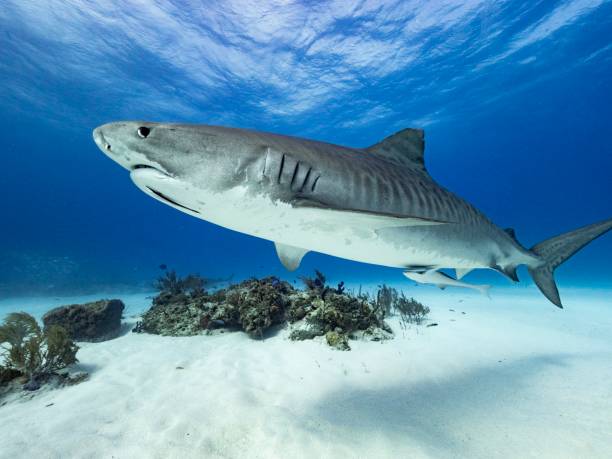
This shark often migrates between Australia and New Zealand during warmer months, but can also be found swimming around coastal areas or near islands. It hunts for fish like eels, toadfish, catfish, flatfishes, cod, sea robins, dogfish
FAQ
Are there shark attacks in the Mediterranean Sea?
Yes, Sharks attacks have been reported in the Mediterranean Sea. also people are encountering sharks in places they never thought possible. Although, shark attacks in the Mediterranean are rare and likely not fatal
Is it dangerous to swim with sharks?
If you love swimming with fish such as Blue baleen whales then yes, I think it’s very dangerous to swim with blue baleen whales because there’s a saying that if you poke them they will puff up or scare so, so try not to get too close.
How do we protect our oceans from Sharks Attacks?
We should stop eating Sharks and other fishes and sea animals because we’re killing our own kind. If we continue doing what we do then eventually we won’t have any more Survival of The Fittest. Think about it! We should start being more respectful towards our own kind.
How do we protect sharks from being hunted?
If people stop eating sharks and don’t go fishing for them then there will be a lot of Sharks that can live longer. Sharks have been around since the start of time so they should have more respect from us humans so it won’t be “Hunting season” on these gentle creatures. Thank you! 🙂
What is the most dangerous animal in the Mediterranean Sea?
The Great White Shark is considered the most dangerous animal in the Mediterranean Sea.
Is it true that sharks are going extinct?
Yes, it’s true that sharks are going extinct and I think most people will agree with me. If we continue doing what we do then eventually most of these animals won’t have a place to live because most humans want to wipe them all out for fun or for money.
What is the biggest shark in the world?
The biggest shark is a Whale Shark, but if you’re talking about length then it would be The Great White Shark, but when they’re born their lengths can vary from 10-73 inches. So, keep that in mind when you see different videos on youtube saying “This shark was this long.” They could just be babies and might even be a few feet smaller than you think.
Conclusions
We hope this article has been useful to you in learning about some of the most common sharks found near the Mediterranean Sea. If you’ve enjoyed reading this article, please share it with your friends or family who might also like it. You may also like to read about other kinds of animals such as Blue baleen whales.





